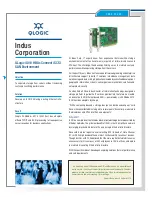
Example 3: Write data into the transmit buffer of channel A.
mov
dx, base
; load base address
out
dx, al
; write data in ax to buffer
Example 4: Read data from the receive buffer of channel A.
mov
dx, base
; load base address
in
al, dx
; write data in ax to buffer
External/Status interrupt information
RR15
Upper byte of baud rate time constant
RR13
Lower byte of baud rate time constant
RR12
Miscellaneous status parameters
RR10
Receive buffer
RR8
MSB of frame byte count and FIFO status register
RR7
LSB of frame byte count register
RR6
Interrupt Pending bits
RR3
Modified Channel B interrupt vector and Unmodified
Channel A interrupt vector
RR2
Special Receive Condition status, residue codes, error
conditions
RR1
Transmit, Receive buffer statuses and external status
RR0
Table 3 --- SCC read register description
The SCC can perform three basic forms of I/O operations: polling, interrupts,
and block transfer. Polling transfers data, without interrupts, by reading the status of
RR0 and then reading or writing data to the SCC buffers via CPU port accesses.
Interrupts on the SCC can be sourced from the receiver, the transmitter, or
External/Status conditions. At the event of an interrupt, Status can be determined, then
data can be written to or read from the SCC via CPU port accesses. Further information
on this subject is found on page 23. For block transfer mode, DMA transfers are used,
so this type of operation is not supported on the MPAC-100.
The SCC incorporates additional circuitry supporting serial communications.
This circuitry includes clocking options, baud rate generator (BRG), data encoding, and
internal loopback. The SCC may be programmed to select one of several sources to
provide the transmit and receive clocks. These clocks can be programmed in WR11 to
come from the RTxC pin, the TRxC pin, the output of the BRG, or the transmit output of
the DPLL. The MPAC-100 uses the TRxC pin for its clock-on-transmit and the RTxC pin
Quatech MPAC-100 User's Manual
23
















































